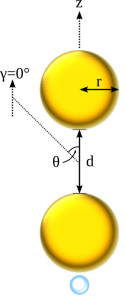The distinct aspect of nanophotonic is that the interaction of light with nanoscale structures is strongly affected by the geometry of the surfaces. This provides the opportunity to use geometry to control electromagnetic interactions, enhancing or suppressing specific multipolar components of the radiation.
From a theoretical point of view, this also means that in nanophotonics we have to use Maxwell equations without the approximations typical of macroscopic optics. The common trait in our works is to calculate the internal and scattering electromagnetic modes of the nanostructures, which are a generalization of the internal and scattering modes of a simple sphere. We then use these modes to calculate the response of the nanostructures to any incident field.
Interesting properties and applications

Sub-wavelength control of light: could be used in ultra high resolution spectroscopy and super high density optical data storage.
Surface enhanced Raman scattering can be used to produce optical sensors, with single molecule resolution.
Surface enhanced fluorescence is used in biological imaging
Extremely low threshold for nonlinear effects, very high Q-factors
Quantum effects are important whenever the nanostructures interact with a small number of emitters, such as molecules or quantum dots.
Find out more about our specific research projects:
- Scattering of light with angular momentum from an array of particles
- Modal decomposition of the electromagnetic response of complex nanostructures
- Many particle “supermodes”
- Our method: a vector form of the Fresnel principle
- Scanning Near Field Microscopy
- Single particle